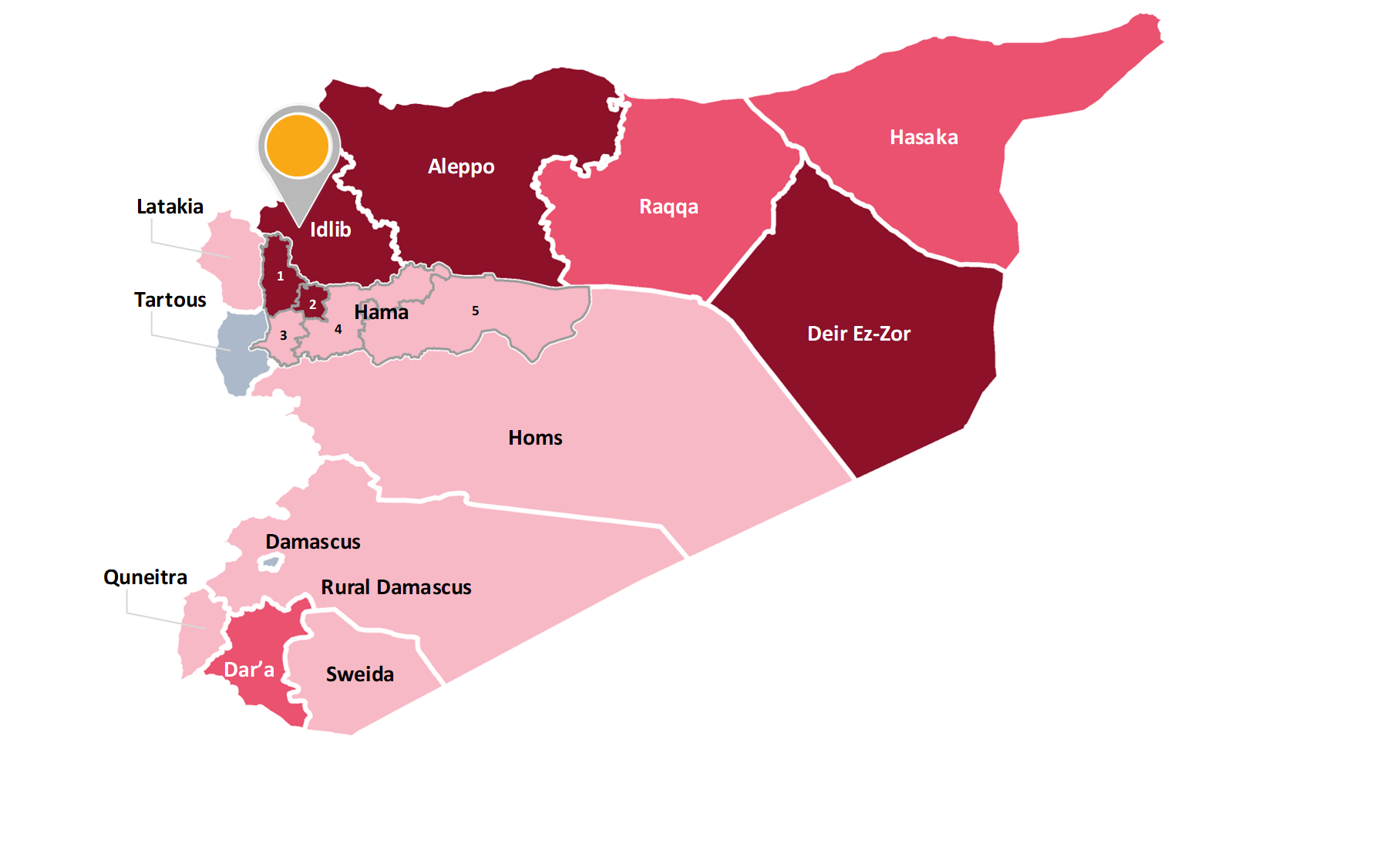[Main COI reference: Security 2020, 2.1]
The governorate of Idlib is located in northwest Syria. It borders the governorates of Hama, Aleppo and Latakia, as well as Turkey. The governorate is divided into five districts: Idlib, Ariha, Jirs-Ash-Shugur, Harim and Al Mara. The Syrian Central Bureau of Statistics estimated the population of Idlib governorate in 2016 to be 1 445 000. Its capital city Idlib is located on the strategic road between Aleppo and Damascus governorates.

Idlib became the refuge for Syrian fleeing the GoS forces, including activists and fighters from areas recaptured by the SAA. Rebels, their families and others who had worked for the opposition were given an opportunity to evacuate to Idlib as part of local reconciliation agreements. Some were also evacuated to the area against their will.
Following an agreement between Russia, Iran and Turkey in May 2017, Idlib governorate became part of a ‘de-escalation’ area, which stipulated the cessation of hostilities and improved humanitarian access. However, GoS forces continued military operations in the area, recapturing half of the de-escalation area by mid-2018. In September 2018, a deal between Russia and Turkey reached at Sochi, created a demilitarised zone in parts of Idlib province. However, by April 2019, the Sochi agreement collapsed following military escalation by GoS, supported by Russia. As of January 2020, half of the governorate remained under the control of anti-government armed groups.
The HTS is the dominant actor in the Idlib area. In the beginning of 2019, the group seized large areas of the governorate following clashes with rival armed groups, and by August 2019 it controlled over 90 % of Idlib governorate, alongside adjacent parts of northern Hama and western Aleppo governorates. A number of other anti-GoS armed groups also operate in the Idlib area (e.g. NLF, TIP, HAD, Ansar al-Tawhid). They are predominantly Islamist groups, who have an ambiguous or symbiotic relationship with HTS. Some of them are backed by Turkey, such as the NLF, an alliance of opposition-armed groups which merged with the SNA in October 2019.
Turkey has 12 military observation points around the Idlib de-escalation zone which were set up after the 2018 deal. In the beginning of 2020, several of these posts have come under fire from GoS forces or were surrounded. Several Turkish military personnel were killed following SAA military operations in Idlib, prompting Turkish retaliatory attacks. Turkish observation points in Idlib were reinforced with armoured personnel carriers and tanks of the Turkish Armed Forces. By mid-February 2020, Turkey was reported to have massed 30 000 troops and armour on the Syrian border and to have sent 5 000 troops to Idlib. Additionally, it has set up military posts in the vicinity of Idlib city.
ISIL was also reported to have a latent presence in Idlib, where the ISIL leader Abu Bakr al-Baghdadi reportedly died in 2019 following a raid by US Special Forces in the village of Barisha.
It is reported that military operations of the GoS in Idlib have been reinforced by Russian, Iranian and Hezbollah forces.
Starting in February 2019, ground offensives and airstrikes on areas controlled by anti-government armed groups escalated significantly, with reports pointing to the deliberate targeting of civilian infrastructure, including hospitals, schools, markets, mosques, residential areas, agricultural resources. As of February 2020, hostilities increased, with frontlines shifting rapidly. A ceasefire negotiated by Russia and Turkey resulted in joint patrolling of a security corridor south and north of the M4 highway, however, as of mid-March 2020, there were already claims by Russian officials that anti-government militants were not complying with the ceasefire.
ACLED recorded 6 447 security incidents (average of 124 security incidents per week) in Idlib governorate in 2019, the large majority of which coded as explosions/remote violence. In the first two months of 2020, the number of security incidents in the governorate was 1 014, amounting to an average of 121 security incidents per week.
During 2019, security incidents occurred in all districts of the governorate, with the largest overall number being recorded in the district of Al Ma’ra.
In 2019, VDC recorded a total of 1 051 civilian fatalities and SNHR recorded a total of 1 506 civilian fatalities in the governorate, the highest number of civilian fatalities recorded out of any province in Syria. Compared to the official figures for the population in the governorate as from 2016, this represents respectively 73 or 104 civilian fatalities per 100 000 inhabitants.
In 2019, Idlib had the highest number of IDP movements in Syria, registering 1 096 000 IDP movements to or within the governorate, of which 950 000 were IDP movements within the governorate. Most IDP movements from Idlib during 2019 were to Aleppo governorate (around 285 000). Displacement continued in 2020. In February 2020, UNOCHA representatives stated that almost 700 000 civilians have been forcibly displaced in Idlib over the past 10 weeks, the largest number of IDPs during such a short time period since the conflict in Syria started.
In 2019, the hostilities in Idlib have resulted in the destruction of entire towns and villages, major damage to civilian infrastructure, the hindering of humanitarian aid, increase in food prices, shelter shortage and severely limited access to basic services. In January 2020, UNOCHA assessed that around 2.7 million people in northwest Syria are in urgent need of humanitarian assistance, including food, shelter, water and sanitation, health and winterisation assistance [see also Security 2020, 1.6.4].
|
|
Looking at the indicators, it can be concluded that the degree of indiscriminate violence in Idlib reaches such a high level, that substantial grounds are shown for believing that a civilian, returned to the governorate, would, solely on account of his or her presence on its territory, face a real risk of being subject to the serious threat referred to in Article 15(c) QD.
|
